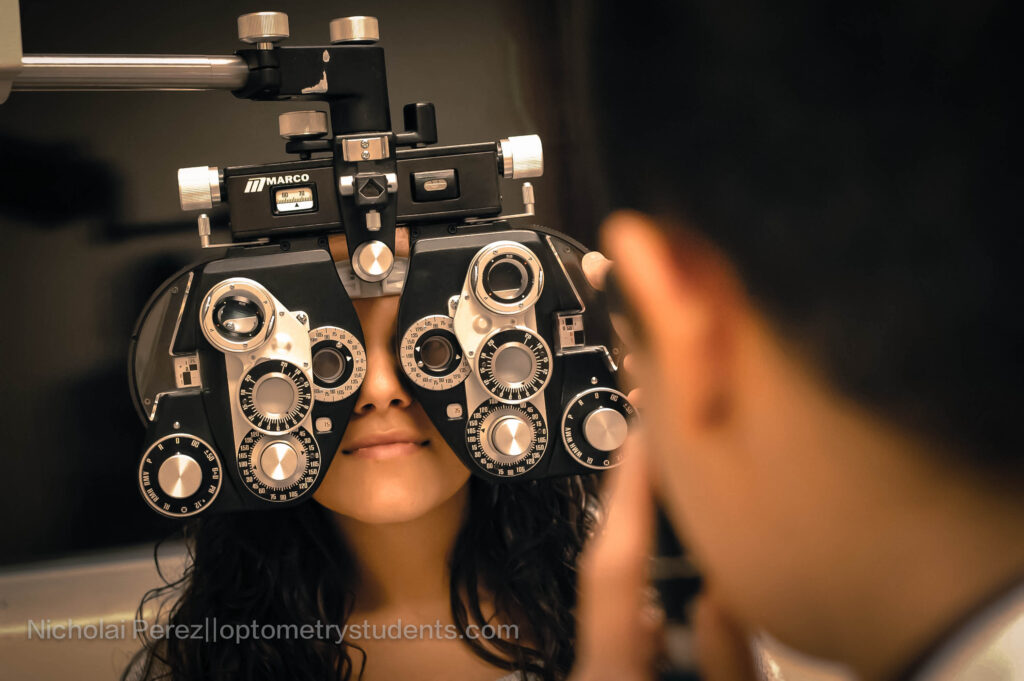Learning from your mistakes is a crucial step in improving yourself as a clinician. After providing regular patient care in the school clinic for a few months as a third year, I’ve seen and made some common mistakes. Here are the top 10 most common mistakes optometry students can make in clinic:
- Occluding one eye in the phoropter during binocularity/phorometry evaluation.
Evaluating a patient’s binocularity behind a phoropter requires the patient to be binocular. If the patient cannot appreciate diplopia while measuring Von Graefe phorias or never demonstrates break in vergence range measurements, then do a quick check that one eye may not accidentally be occluded. - Not asking for the patient’s occupation or vocational vision needs.
The best clinician provides care for the patient’s health and his or her livelihood. Get an idea of what your patient does for a living or for fun so you can address any vision issues before they arise. An emerging presbyope who enjoys target shooting may not see the markings within his rifle scope and mistakenly blames it on defective equipment. A construction worker may wonder why his eyes are always irritated after work but forgets to mention it to you during case history. - Checking the cornea with diffuse and 0º straight-on illumination on the slit lamp instead of a parallelpiped at 40-60º.
If you are rushing through your slit lamp evaluation, you may forget to change the light housing angle to evaluate different layers of the cornea after evaluating the lids and conjunctiva. All the diffuse light will drown out any detail of the cornea, and you will not evaluate any underlying corneal layers like the stroma and endothelium without increasing the light housing angle. Check out this great article for more information about slit lamp techniques! - Not educating patients on the purpose of each test.
Patients generally appreciate understanding what is happening during an eye exam. By explaining the purpose of each procedure, you are educating and conveying they value of the eye exam. “Look at the light,” does not sound very important compared to, “Look at the light so I can ensure your cornea is healthy and can provide clear vision.” Additionally, patients assume they can’t ever blink during an eye exam, so please tell your patients if they can freely blink. - Running a visual field evaluation binocularly.
Visual fields must be evaluated monocularly to check for unilateral eye disease. In your haste to set up the visual field, you may have forgotten the simplest step – an eye patch. Put an eye patch on the patient first before hitting any buttons on the visual field machine. This is especially important before starting a ten minute threshold visual field that ends with, “Ok, that was practice. Let’s do the real thing now!” - Performing Goldmann Applanation Tonometry without any prior anesthetic.
Don’t do this. If you have made this mistake, you will probably never forget the scream from the patient. - Prescribing medication without asking about allergies or checking contraindications.
The power to prescribe comes with great responsibility to ensure patient safety. Always double-check your target medication’s contraindications with the patient’s allergies and history. Epocrates is a great application that you should install on your phone just for this. Find out about other great optometry apps here! - Forgetting your patient’s chief complaint at the end of the exam.
Remember the chief complaint is what motivated the patient to see you for an eye exam. Even if you find a whole collection of disease in the eyes, you must address the chief complaint before the end of the visit. Solve the chief complaint first and then address any other findings afterwards. - Arguing with the patient
Sometimes patients have personal beliefs that oppose your health recommendations (such as medication treatment for glaucoma). Arguing with the patient to impose your opinion is not the solution. A great optometrist provides education and recommendations and allows the patient to take part in the decision making process. - Assuming things about patients.
Assuming something about someone you just met is the biggest mistake you can make when providing patient care. We will all see many different kinds of patients in our time in clinic. Our responsibility is to provide the best options for care to the patient regardless of their socioeconomic class, age, or ethnicity. Here are some scenarios when assumptions you make may kick you in the butt:
- Young patients will not always be the easiest eye exam and capable of correcting to 20/20 in each eye. You may be the first to catch amblyopia.
- Social class does not predict health care spending habits. Your patient may want the best contacts out there or have been dreaming of LASIK even if he mentioned missing rent this month.
- Patients who know they have been diagnosed with systemic diseases are not always compliant with their medications to treat it. Diabetics may not have controlled blood sugar levels even though they know they are diabetic and had medications prescribed.
- Ask patients with cataracts about glare problems or hindered activities during daily living before saying, “I see no need for surgery at this time.”
These are just a few of the common mistakes that my fellow optometry students and I have made in clinic. Embrace your mistakes and learn from them. One step backwards can turn into two steps forward on your optometric path.


